Related Research Articles
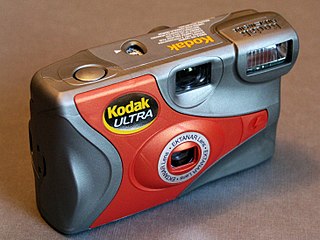
A disposable or single-use camera is a simple box camera meant to be used once. Most use fixed-focus lenses. Some are equipped with an integrated flash unit, and there are even waterproof versions for underwater photography. Internally, the cameras use a 135 film or an APS cartridge.

The xD-Picture Card is an obsolete form of flash memory card, used in digital cameras made by Olympus, Fujifilm, and Kodak during the 2000s. The xD in the xD-Picture Card stands for eXtreme Digital.

A digital single-lens reflex camera is a digital camera that combines the optics and the mechanisms of a single-lens reflex camera with a solid-state image sensor and digitally records the images from the sensor.
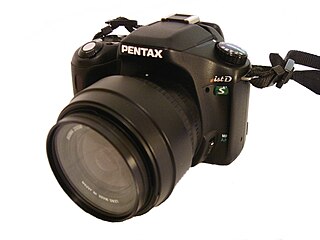
PENTAX *ist DS is a digital SLR camera produced by Pentax. The *ist DS produces a 6.1 megapixel resolution image. The *ist DS was a lower-prices follow-on to the Pentax *ist D. In September 2005 the Digital Imaging Websites Association (DIWA), a worldwide organization of collaborating websites, announced that Pentax had received their first DIWA Award for a DSLR camera. The *ist DS model was awarded with a Silver medal for outstanding test results.

Digital photography uses cameras containing arrays of electronic photodetectors interfaced to an analog-to-digital converter (ADC) to produce images focused by a lens, as opposed to an exposure on photographic film. The digitized image is stored as a computer file ready for further digital processing, viewing, electronic publishing, or digital printing. It is a form of digital imaging based on gathering visible light.
In a Windows network, NT LAN Manager (NTLM) is a suite of Microsoft security protocols intended to provide authentication, integrity, and confidentiality to users. NTLM is the successor to the authentication protocol in Microsoft LAN Manager (LANMAN), an older Microsoft product. The NTLM protocol suite is implemented in a Security Support Provider, which combines the LAN Manager authentication protocol, NTLMv1, NTLMv2 and NTLM2 Session protocols in a single package. Whether these protocols are used or can be used on a system which is governed by Group Policy settings, for which different versions of Windows have different default settings.

Live preview is a feature that allows a digital camera's display screen to be used as a viewfinder. This provides a means of previewing framing and other exposure before taking the photograph. In most such cameras, the preview is generated by means of continuously and directly projecting the image formed by the lens onto the main image sensor. This in turn feeds the electronic screen with the live preview image. The electronic screen can be either a liquid crystal display (LCD) or an electronic viewfinder (EVF).

The Canon EOS 40D is a 10.1-megapixel semi-professional digital single-lens reflex camera. It was initially announced on 20 August 2007 and was released at the end of that month. It is the successor of the Canon EOS 30D, and is succeeded by the EOS 50D. It can accept EF and EF-S lenses. Like its predecessor, it uses an APS-C sized image sensor, resulting in a 1.6x field of view crop factor.

An image processor, also known as an image processing engine, image processing unit (IPU), or image signal processor (ISP), is a type of media processor or specialized digital signal processor (DSP) used for image processing, in digital cameras or other devices. Image processors often employ parallel computing even with SIMD or MIMD technologies to increase speed and efficiency. The digital image processing engine can perform a range of tasks. To increase the system integration on embedded devices, often it is a system on a chip with multi-core processor architecture.

The Pentax K20D and its clone, the Samsung GX-20, are 14.6 megapixel digital single-lens reflex cameras manufactured by Pentax that were announced on January 23, 2008. The K20D was available in the U.S. market from February 2008 through autumn 2009.
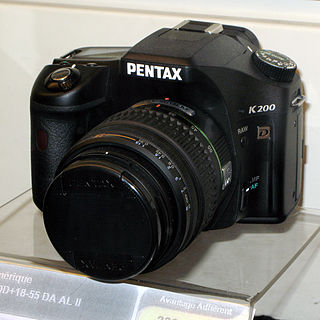
The Pentax K200D is a 10.2-megapixel digital single-lens reflex camera, announced on January 24, 2008, along with the higher-end K20D. It was discontinued in December 2008, giving it the distinction of being one of the shortest-lived DSLR cameras.
This article discusses the cameras – mainly 35 mm SLRs – manufactured by Pentax Ricoh Imaging Corp. and its predecessors, Pentax Corporation and Asahi Optical Co., Ltd.. Pentax must not be confused with Pentax 6x7 or Pentax 67 which are 120 medium format 6x7cm film cameras.

Pentax lenses were first badged as Takumar. The Takumar branded lenses were well respected for their line of Super Takumar, which designated the high performance coating applied to the lens as well as the optical formulas used to make them. The majority of the industry at the time was still satisfied with the variations of the "plumb" coating process and later some of the two and three layer processes as well. Asahi Pentax soon introduced the Takumar Super-Multi-Coated line of lenses which was a 7 layer process as the industry had just caught up with similar forms of 5 layer multi-coated optics. Eventually Asahi Optical and Pentax slowly shifted much of their lens production under the Pentax name and transitioned some of the successful designs that were first introduced under the Takumar name to use Asahi/Pentax badging as well as beginning to use the "smc" abbreviation. Eventually the Asahi partnership disappeared and the Pentax name became solely used. Pentax lenses saw many feature changes to answer the market, such as: incorporating "Auto-Aperture" with the M42, the light weight and compactness with the 'M' series, Aperture Priority overrides with the 'A' series, and Auto-Focus with the 'F' series. Modern Pentax lenses for digital SLR cameras have seen the elimination of the aperture ring completely as found on Pentax DA and D-FA series lenses. They use the Pentax KAF mount. All of these lenses have an autofocus feature, either operated from the camera body or from an internal SDM motor. Pentax compatible lenses are also made by third-party companies.

The Pentax *ist DL is a 2005 entry-level digital single lens-reflex camera manufactured by Pentax.

The Pentax K-x is a 12.4 megapixel digital single-lens reflex camera, which was announced on September 16, 2009. The Pentax K-x uses a Sony Exmor sensor. In some cases it even approaches the quality produced by full-frame DSLRs like the Nikon D700 and the Canon 5DMkII, both with larger sensors. The Pentax K-x is suitable for low light conditions for both still and video photography.
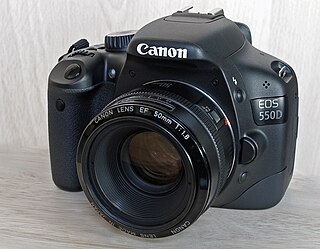
The Canon EOS 550D is an 18.0-megapixel digital single-lens reflex camera, announced by Canon on 8 February 2010. It was available since 24 February 2010, and to US dealers from early March. It is known as the EOS Kiss X4 in Japan, and as the EOS Rebel T2i in the Americas. It is part of Canon's entry- / mid-level digital SLR camera series, and was the successor model to the EOS 500D. It was succeeded by the EOS 600D but remained in Canon's lineup until being discontinued in June 2012 with the announcement of the EOS 650D.
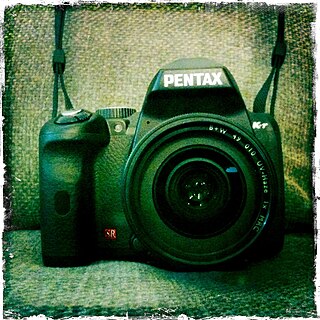
The Pentax K-r is a 12.4-megapixel digital single-lens reflex camera, announced on September 9, 2010, and replaced the K-x in Pentax' line-up, with which it shares many features. The K-r is available in three body colors in North America, with other colors available only in the Japanese market. The K-r introduces a new SAFOX IX autofocus system and has a 3-inch display. The image quality of Pentax K-r and K-x is identical, but colour fidelity in JPEG output has been increased. The K-r has been improved over the K-x in other areas, such as the K-r showing the active focus point in the viewfinder when the shutter button is half-pressed, the K-r offering the joint second-widest ISO range in the Pentax line-up along with K-30—100-25600 in extended mode, which only the K-5 exceeds, having the joint second-fastest continuous shooting of current Pentax DSLRs, and using rechargeable battery Li-Ion D-LI109 as standard, but having the ability to use 4 × AA batteries with optional battery holder. The K-r also has a slightly larger, and much higher resolving display at 921,000 pixels vs. the K-x's 230,000.

The Nikon Expeed image/video processors are media processors for Nikon's digital cameras. They perform a large number of tasks: Bayer filtering, demosaicing, image sensor corrections/dark-frame subtraction, image noise reduction, image sharpening, image scaling, gamma correction, image enhancement/Active D-Lighting, colorspace conversion, chroma subsampling, framerate conversion, lens distortion/chromatic aberration correction, image compression/JPEG encoding, video compression, display/video interface driving, digital image editing, face detection, audio processing/compression/encoding and computer data storage/data transmission.
The Pentax X-5 is a digital "bridge" and superzoom camera from Japanese camera maker Pentax, featuring a 16 megapixel sensor and 26 times zoom for a final 35mm focal length equivalent of 580mm, as well as 1080p video capability. It was announced in August 2012 and became available in September 2012. The previous X-designated camera in Pentax' line-up was the Pentax X90.
References
- ↑ Tomkins, Mike (9 October 2001). "Pentax, Sanyo cooperate on single-use digicam!". Imaging-Resource. Retrieved 1 December 2023.
- ↑ Tomkins, Mike (31 July 2003). "Ritz prepares to sell single-use digicams". Imaging-Resource. Retrieved 1 December 2023.
- ↑ Maushammer, John. "Disposable Digital Camera Interfacing - Pure Digital's Ritz Camera Dakota variant". Archived from the original on 3 April 2008. Retrieved 1 December 2023.
{{cite web}}: CS1 maint: unfit URL (link) - ↑ Gipson, Tim R. (6 November 2003). "Use the (PureDigital) Dakota Digital Camera with your PC". Counterexploitation - cexx.org. Retrieved 1 December 2023.
- ↑ "Ritz Disposable Digital Camera Hacked". Slashdot. 12 November 2003. Retrieved 1 December 2023.
- ↑ Balerdi, Rodrigo (26 July 2004). "Dakota Digital Camera". Archived from the original on 12 February 2009. Retrieved 1 December 2023.
- ↑ Maushammer, John. "Disposable Digital Camera Interfacing - Pure Digital's Ritz Camera Dakota PV2 LCD variant". Archived from the original on 25 March 2008. Retrieved 1 December 2023.
{{cite web}}: CS1 maint: unfit URL (link) - ↑ Maushammer, John. "Pure Digital's PV2 Disposable Digital Camera - FAQs". Archived from the original on 20 March 2008. Retrieved 1 December 2023.
{{cite web}}: CS1 maint: unfit URL (link) - ↑ Sicha, Choire (12 April 2011). "The Flip Video Story: 10 Years of Iteration, Fighting the Future and Selling Out". The Awl. Retrieved 1 December 2023.